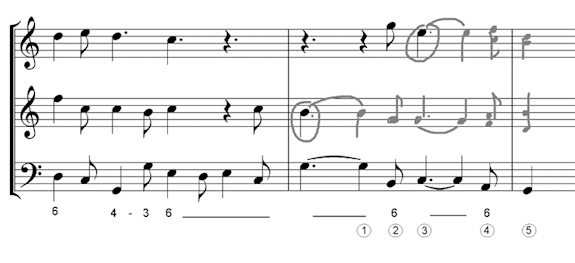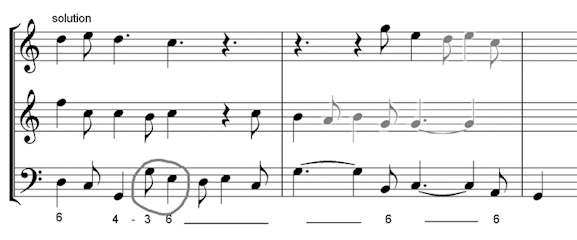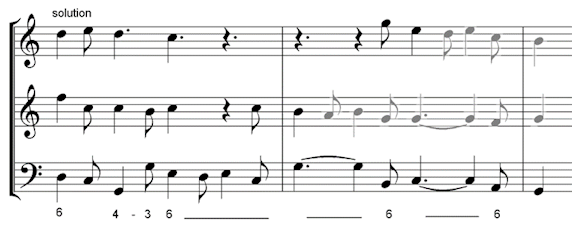Step 5. Momentum
At this stage your Trio Sonata should look almost complete, but it is probably not quite finished yet. In this step we will ensure there is sufficient rhythmic movement (momentum) throughout.
The music needs to move at a steady pace (usually quavers (8th notes), but perhaps longer notes, depending on the tempo) at all times, except at a cadence. Look at the pace set at the start and make sure the same momentum is continued throughout, by using the same kind of note values.
Fast rhythms usually only occur in one part at a time. If one part has several quavers (8th notes), the others do not usually need them. The fast notes can occur in one part over a number of bars, or they might be split between parts.
Homorhythmic bars (i.e. using the same rhythm in two or three parts simultaneously) are not typical, with a couple of exceptions:
- Homorhythmic openings are fairly common, but only last around 2-4 bars.
- Scales (or sections of scales) and arpeggios are sometimes homorhythmic. Scales would be harmonised in 3rds or 6ths.
Semiquavers (16th notes) normally only continue by a stepwise movement, (or can sometimes outline an arpeggio).
In this example (from the middle of a Trio, in 12/8 time) we can start by filling in the “required” notes and create complete chords:
- At ①, we need a third (B).
- At ② the third appears in the bass. It’s the leading note, so we can’t double it, so the middle part changes to G.
- At ③, we stay on G, as we already have a root and third.
- At ④, there are a number of possibilities, and it’s not clear which is best.
- At ⑤ it is still unclear.

Although we have made complete chords, look at what happens to the momentum if we simply join up these notes: the rhythmic movement stops on the first and third beats of the bar, and the end of the bar is homorhythmic, which is not appropriate at this stage in the piece. In addition, the given crotchets (quarter notes) (circled) suggest that the next note should be a quaver (8th note), and we should not extend them into dotted notes.

To fix these momentum issues, start by looking for a nearby existing pattern which can be used for the first G major chord.
The nearest pattern in the bass part consists of chord note E, auxiliary note D, chord notes E and C. Try this pattern to see if it works with the harmony:

This fits perfectly. The leading note Bs in the middle part do not need to resolve, because the last sounding B in this chord is the one in the bass, which does resolve. So, we can use G again as the next note in the middle part, which creates a complete triad for the C major chord.
Now look at the top part. This also has G-E, like the bass in the first bar, so we can try that pattern again. The middle part can be given a sustained note, because the top part is moving. Now we have imitation/sequence of this idea, over all three parts.

The F major first inversion chord at the end of the second bar is missing its root, so the middle part needs F, and we can then see how the next chord fits too. Move to G in the middle part, rather than D (always move by the smallest possible interval at a cadence).
